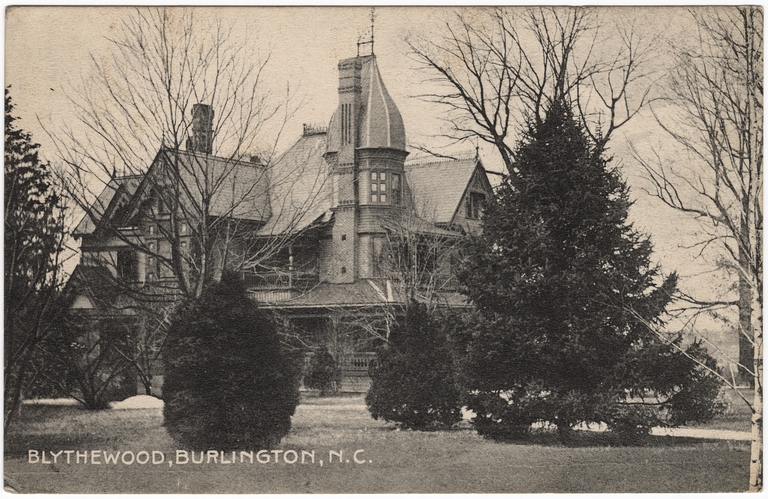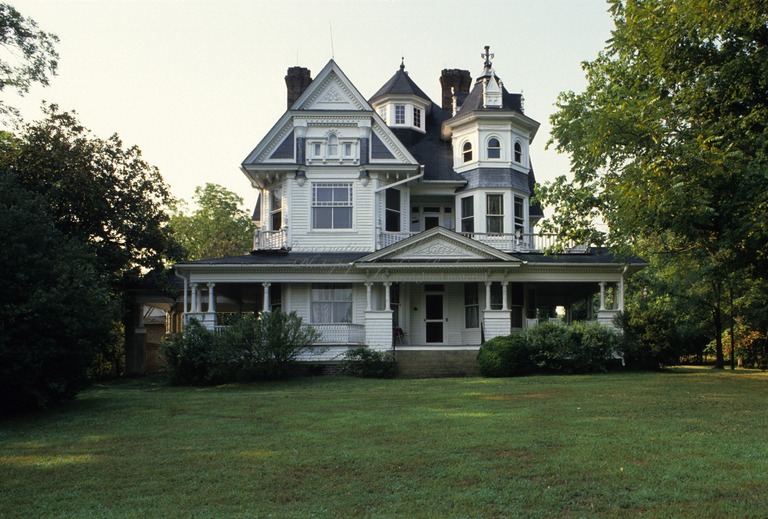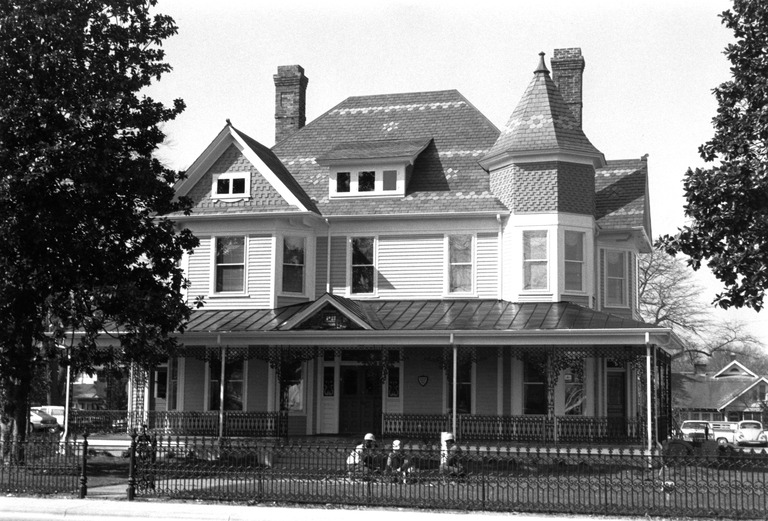Kluttz, Thomas A. (1862-1907)
Variant Name(s):
Klutz, Thomas A.; Kluttz, T. A
Birthplace:
Rowan County, North Carolina, USA
Residences:
- Hickory, North Carolina
- Knoxville, Tennessee
Trades:
- Builder
- Architect
Building Types:
Styles & Forms:
Colonial Revival; Queen Anne
Thomas A. Kluttz (March 5, 1862-November 5, 1907) was a native of North Carolina who emerged in the 1880s as architect and superintendent for several buildings in the state, and in 1895 entered into a partnership with Knoxville mail-order architect George F. Barber. The resulting firm produced designs for many houses in North Carolina and in other states.
According to “First Families of Knoxville,” Thomas A. Kluttz was born in 1862 to Eli and Mary Elizabeth Linn Kluttz, who in 1860 were residents of Rowan County, N. C. Also in the Kluttz household in 1860 was Mary’s brother, Thomas Linn, aged 24, an apprentice house carpenter. Thomas A. Kluttz and his sister Mary (1867-1933) were orphaned at young ages: their mother died on March 31, 1867, shortly after Mary’s birth, and their father Eli died in 1874. The two orphaned siblings made their home with their uncle, mechanic and house carpenter Thomas Linn, from whom Thomas Kluttz probably obtained some or all of his training in construction. In 1880 the United States Census listed Thomas A. Klutz, single at age 19, and his sister, Mary, aged 13, living in Linn’s large household in Hickory, N. C. Both Thomas Kluttz and Thomas Linn were noted as “mechanics.” (The term “mechanic” referred to various handicraft trades and was often used for builders. Thomas A. Kluttz married Annie Boone in 1888 in Cumberland County, N. C., and they had a daughter, Jeannie or Jennie (1889-1909).
During the 1880s, Thomas Kluttz established himself in Fayetteville, N. C. as an architect and builder, and in the late 1880s and early 1890s, he regularly advertised his services as architect and superintendent in the Fayetteville Weekly Observer. He gained commissions for several prominent projects. In Fayetteville in 1887 he planned a new spire for the venerable and prestigious First Presbyterian Church to replace a spire that had deteriorated. (The 1887 spire was later replaced, and a portico was added by architect Hobart Upjohn of New York.) Likewise in 1887, the Fayetteville Weekly Observer of November 3 reported that Kluttz had superintended the completion of the Hotel LaFayette from designs by a Richmond architect, one H. Jackson. The Raleigh News and Observer of May 2, 1888, carried a report from Fayetteville that he had completed a “handsome new residence” on Railroad Street for Mr. A. E. Rankin. The account said it was “perhaps the neatest and most commodious dwelling in East Fayetteville,” and identified Kluttz as an “eminent architect” of Fayetteville. The Fayetteville Weekly Observer of June 27, 1888, reported that he was executing renovations at St. John’s Episcopal Church (see William Drummond). The same newspaper reported on June 4, 1891 that Kluttz had newly completed the Red Springs Hotel in that Robeson County town. The report cited Kluttz as a “well-known architect” and lauded the hotel for its tasteful appearance and comfortable arrangements, including “roomy piazzas” that “encircled” the hotel on the first and second floors,” allowing “a siesta completely sheltered from the sun” at all hours of the day. At the time, Red Springs was a popular summer mineral springs resort. During this period, architect and builder John C. Stout is described as having trained for three years in Kluttz’s office. Stout moved to Wilmington, where he became a prominent contractor and architect in the 1890s, and he later practiced in Rocky Mount and elsewhere.
In about 1895 Kluttz entered into a business partnership with the prolific mail-order architect George F. Barber. How that connection was made is not yet established. Kluttz and his family moved to Knoxville, where he stayed for the rest of his life and continued the association with Barber, working primarily in various Queen Anne and Colonial Revival modes. The United States Census of 1900 recorded in Knoxville architect Thomas A. Klutz, his wife Annie, a native of Florida, and their daughter, Jennie, aged 10. Kluttz was also listed in the Knoxville City Directories of 1903, 1904, and 1906. Several North Carolina houses are cited or documented to the firm of Barber and Kluttz, including the large Colonial Revival style Dred and Ellen Yelverton House in Wayne County, N. C., for which plans survive marked “Barber and Kluttz.” The building list below includes works cited to Barber and Kluttz as well as those cited to Thomas A. Kluttz alone.
In 1907, the Manufacturers’ Record of December 12 carried an announcement that the firm of Barber and Kluttz, architects, had been discontinued due to Kluttz’s death the previous month, but that it would continue under Barber’s name. “The firm has ample facilities for preparing plans and specifications for and superintending the construction of all classes of buildings, and has planned some of the most important structures in the South. It has various new orders now in prospect.” Thomas A. Kluttz was buried in the Old Gray Cemetery in Knoxville, where his marker shows his birth and death dates as March 5, 1862-November 5, 1907. As noted in findagrave.com, he was predeceased by his wife Annie Boone Kluttz (1872-1903).
A. E. Rankin House
Contributors:Thomas A. Kluttz, architectDates:1888
Location:Fayetteville, Cumberland CountyStreet Address:Fayetteville, NC
Status:Unknown
Type:Residential
Alexander Martin Smith House
Contributors:George F. Barber, architect; Barber and Kluttz, architects; T. A. Dean, builder; Thomas A. Kluttz, architectDates:1897
Location:Elkin, Surry CountyStreet Address:131 Gwyn Ave., Elkin, NC
Status:Standing
Type:Residential
Images Published In:Catherine W. Bishir, North Carolina Architecture (1990).
Catherine W. Bishir, Michael T. Southern, and Jennifer F. Martin, A Guide to the Historic Architecture of Western North Carolina (1999).Note:The Alexander Martin Smith House, one of the best preserved of Barber’s designs, is also one of the grandest and most ornate surviving Queen Anne style residence in the state.
Blythewood
Contributors:George F. Barber, architect; Barber and Kluttz, architects; Thomas A. Kluttz, architectVariant Name(s):Lawrence S. Holt, Sr., House
Dates:Ca. 1896
Location:Burlington, Alamance CountyStreet Address:Lexington Ave., Burlington, NC
Status:No longer standing
Type:Residential
Images Published In:Allison Harris Black, An Architectural History of Burlington, North Carolina (1987).
Note:Blythewood, built for one of the pioneering textile family of Holts, was among Barber and Kluttz’s most dramatically composed and richly ornamented houses in the Piedmont. It was one of several grand mansions built for textile families in Alamance County, most of which have been lost.
Bullock-Dew House
Contributors:George F. Barber, architect; Barber and Kluttz, architects; Thomas A. Kluttz, architectDates:Ca. 1902
Location:Wilson CountyStreet Address:SR 1136, Wilson vicinity, NC
Status:Unknown
Type:Residential
Images Published In:Catherine W. Bishir and Michael T. Southern, A Guide to the Historic Architecture of Eastern North Carolina (1996).
Charles T. Holt House
Contributors:George F. Barber, architect; Barber and Kluttz, architects; Thomas A. Kluttz, architect; James R. Montgomery, builderDates:1897
Location:Haw River, Alamance CountyStreet Address:228 Holt St., Haw River, NC
Status:Standing
Type:Residential
Images Published In:Catherine W. Bishir, North Carolina Architecture (1990).
Catherine W. Bishir and Michael T. Southern, A Guide to the Historic Architecture of Piedmont North Carolina (2003).
David L. Gaskill House
Contributors:George F. Barber, architect; Barber and Kluttz, architects; Thomas A. Kluttz, architectDates:1898
Location:Salisbury, Rowan CountyStreet Address:402 S. Ellis St., Salisbury, NC
Status:Standing
Type:Residential
Images Published In:Davyd Foard Hood, The Architecture of Rowan County North Carolina: A Catalogue and History of Surviving 18th, 19th, and Early 20th Century Structures (1983).
Dr. Isaiah Fearing House
Contributors:George F. Barber, architect; Barber and Kluttz, architects; Thomas A. Kluttz, architect; John William Martin, builderDates:Ca. 1905
Location:Elizabeth City, Pasquotank CountyStreet Address:203 W. Main St., Elizabeth City, NC
Status:Standing
Type:Residential
Images Published In:Thomas R. Butchko, On the Shores of the Pasquotank: The Architectural Heritage of Elizabeth City and Pasquotank County, North Carolina (1989).
Note:The large frame house was built by Martin from a design by Barber. Displaying the popular “Southern Colonial” style, it is symmetrical in overall form and features a two-tier, pedimented entrance portico and flanking 1-story porches.
Dr. R. P. Anderson House
Contributors:George F. Barber, architect; Barber and Kluttz, architects; Thomas A. Kluttz, architectDates:1903
Location:Mocksville, Davie CountyStreet Address:665 N. Main St., Mocksville, NC
Status:Standing
Type:Residential
Images Published In:Kirk Franklin Mohney, The Historic Architecture of Davie County, North Carolina: An Inventory Analysis and Documentary Catalogue (1986).
Note:The strikingly composed house, a bold element in its streetscape, features a capacious round tower and asymmetrical façade, complemented by distinctive rough stonework.
Dred and Ellen Yelverton House
Contributors:George F. Barber, architect; Barber and Kluttz, architects; Thomas A. Kluttz, architectDates:Ca. 1900; ca. 1913
Location:Fremont, Wayne CountyStreet Address:1979 NC Highway 222 East, Fremont vicinity, NC
Status:Standing
Type:Residential
Images Published In:J. Daniel Pezzoni and Penne Smith, Glimpses of Wayne County, North Carolina: An Architectural History (1998).
Note:According to the National Register of Historic Places nomination for the Yelverton House (Ruth Little, 2009), family tradition reports that in about 1900 Etheldred (“Dred”) Yelverton hired a local contractor, Claude Dickerson, to build a new house for himself and his family, to replace one that had burned. It was to follow blueprints from Barber and Kluttz. Problems with the contractor resulted in a long delay in completing the house, which was accomplished by a different contractor in 1913, following Dred Yelverton’s marriage to Cherry Ellen Davis in 1912. (The undated blueprints, marked “Res for T. E. Yelverton, Fremont, NC” and the firm name “Barber & Kluttz” survive in private hands. T. E. Yelverton was a prominent citizen of Goldsboro; why his name is on these plans is not established. Possibly he gave the plans to Etheldred. ) Combining elements of the Queen Anne and Colonial Revival styles, the house is unusually imposing for a rural residence in eastern North Carolina. It has continued in family ownership.
Hotel LaFayette
Contributors:H. Jackson, architect; Thomas A. Kluttz, superintendentDates:1887
Location:Fayetteville, Cumberland CountyStreet Address:Fayetteville, NC
Status:No longer standing
Type:Commercial
Note:The Fayetteville Weekly Observer of November 3, 1887 reported that Kluttz had superintended the construction of the Hotel LaFayette from designs by Richmond architect H. Jackson. As pictured in subsequent issues of the newspaper, it was a 3 1/2 story edifice in ornate Second Empire style with a corner tower. It was either replaced or heavily remodeled in the early 20th century, as indicated in postcards.
James L. Fleming House
Contributors:George F. Barber, architect; Barber and Kluttz, architects; Thomas A. Kluttz, architect; C. B. West, builderDates:1902
Location:Greenville, Pitt CountyStreet Address:302 S. Greene St., Greenville, NC
Status:Standing
Type:Residential
Images Published In:Catherine W. Bishir and Michael T. Southern, A Guide to the Historic Architecture of Eastern North Carolina (1996).
Michael Cotter, ed., The Architectural Heritage of Greenville, North Carolina (1988).Note:The splendid Queen Anne style house was built for the founder of East Carolina University.
Lilly Grandy House
Contributors:George F. Barber, architect; Barber and Kluttz, architects; Thomas A. Kluttz, architectDates:1897
Location:Elizabeth City, Pasquotank CountyStreet Address:504 W. Main St., Elizabeth City, NC
Status:Standing
Type:Residential
Images Published In:Thomas R. Butchko, On the Shores of the Pasquotank: The Architectural Heritage of Elizabeth City and Pasquotank County, North Carolina (1989).
Red Springs Hotel
Contributors:Thomas A. Kluttz, architectDates:1891
Location:Red Springs, Robeson CountyStreet Address:Red Springs, NC
Status:Altered
Type:Commercial
Thomas H. Briggs House
Contributors:George F. Barber, architect; Barber and Kluttz, architects; Thomas A. Kluttz, architectDates:1896
Location:Raleigh, Wake CountyStreet Address:W. Edenton St., Raleigh, NC
Status:No longer standing
Type:Residential
Images Published In:Norman D. Anderson and B. T. Fowler, Raleigh: North Carolina’s Capital City on Postcards (1996, 2000, 2002).
Note:Extensive documentation of the construction of the house survives in the Briggs papers at the North Carolina State Archives.
William J. Leary House
Contributors:George F. Barber, architect; Barber and Kluttz, architects; Thomas A. Kluttz, architect; Theo Ralph, contractorDates:1897
Location:Edenton, Chowan CountyStreet Address:203 E. Water St., Edenton, NC
Status:Standing
Type:Residential
Images Published In:Thomas R. Butchko, Edenton, an Architectural Portrait: The Historic Architecture of Edenton, North Carolina (1992).
Note:According to Thomas R. Butchko, the Leary family considered two plans by Barber to expand an existing house. They selected Design No. 1 in Barber’s Cottage Souvenir, Number 2 (1891). A drawing by Barber for “Change of Residence for Mrs. William Leary” is reproduced in Butchko, Edenton: An Architectural Portrait, as is the agreement of 1897 between local builder Theo Ralph and Mrs. Emma W. (William J.) Leary, which described every component and stated that the work was to be done according to “plans and specifications sent out by Geo. F. Barber & Co. of Knoxville, Tennessee.” It made reference to reuse of some materials from the previous house, and also to certain features of the new house “exactly like” Mrs. Dixon’s, indicating that the Dixon-Powell House may have been by Barber and/or Ralph as well.






